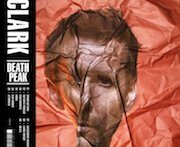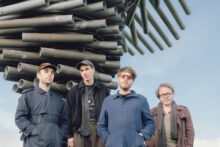Andrew PM Hunt imagines a future archaeologist to shape a music of tomorrow from fragments of the past. Although Atlas Of Green maintains a stylistic connection to previous works under the Liverpudlian musician’s Dialect moniker, it’s also a distinctly new limb of his storytelling. Born out of our civilization’s current predicaments, it branches off into ancient history and speculative futures – a rejigging of sounds and music around us into an approaching myth.
The Gene Wolfe-inspired ‘New Sun’ gives us a first glimpse of how our world and the worlds that came before it might be reconstructed in some distant future in which a folk tale is all that’s left of us. Screeching, rusty cello lines grow into voluminous guitar effusions, like an orchestra warming up, while each guitar strum sprouts into immense, deeply resonant notes. A cluster of synthesiser lines, piano keys, and answering machine beeps swirls below, and overjoyed flute licks dance a solitary dance above. This vaguely pastoral orchestra wobbles up and down, reminiscent of dandelions swaying on a soft summer breeze. Shards of ebullient pop, Day-Glo electronica, ambient Americana, roots music, and mediaeval song somehow come to occupy the same space and time. Their crescendo shoots sharply upwards, then floats softly back down to earth.
While Hunt’s work with the group Outfit in the early to mid 2010s veered towards conventional, rock-adjacent musical forms, his output in the past decade with JC Leisure (Raft Of Trash), Benjamin D. Duvall (Land Trance), and Ex-Easter Island Head has seen him embrace the uncertain. Hunt’s solo project Dialect is particularly outré in this sense, as he bundles together loose threads of avant chamber, spectral electronics, found sound, tape loops, and improvisation as fragile as the crumbling organic and technological systems they embody.
The gnarly beauty of Dialect’s 2015 record Gowanus Drifts turned images of an industrial society on the brink of collapse into a heaviness that haunted pulsing, growling dark ambient architectures, evoking a perversion of Fourth World aesthetics. 2017’s Loose Blooms grew boundless textures from delicate effects, letting soundscapes spread like ivy from gritty cello lines and distorted electronics. Meanwhile, 2021’s Under~Between shimmered with the hope of growing melodies seeded by Hunt and his community of local collaborators.
Beneath the surface, each of these albums was informed by a sense of ecological anxiety and existential dread, as if reflecting the groans and pains of a world dying in slow motion. With Atlas Of Green, Hunt steps far into the future, hitting fast-forward on our imminent disintegration, skipping over the conflicts and decay of a post-apocalyptic landscape and diving into another life that comes after it. There, a young musician named Green pieces together myth and music from the remnants of our long forgotten society.
The songs flow into one another as if forming a continuum: the boundaries between them imperceptible, the shifts from melody to melody and from theme to theme instead entrusted to mutations within each of their bodies. The opening ‘New Sun’ thus loses itself in strangely nostalgic, jumbled sounds that might have once been field recordings halfway through ‘Recreation Story’, only for ‘Born Through’ to discover a plump funk bass line in the embers of some never written folk song.
Similar to our own imperfect restorations of archaeological artefacts – colourless sculptures from Ancient Greece, Omm Sety’s fever dream visions of the Temple Of Seti I in Abydos – the music is built from patches collected from different eras and areas: sounds misinterpreted, repurposed, and mushed together into something alien but familiar. Digital glitches, whistles, and bird chirrups join in collective singsong on ‘Spiral Cartography’, before transforming into the stuttering pop of ‘Overgrown Song’. Later, the stunningly melancholic symphony of transmogrified voice slivers and bucolic mandolin strums wreaks havoc on ‘Late Fragment’.
Elsewhere, ‘Green’s Dream’ breaks down melodies into fluttering ephemera and rearranges them into the thrillingly dynamic electronica swing of ‘Archaic Quarter Form’, which appears plucked from a Caribou or Clark record, only for it to be punctuated by a simultaneously hilariously kitsch and sublime faux trumpet vamp. Cartoonish, pitch-shifted voices and blaring noises circle each other on ‘Atlas Of Green’, then disappear into mist like a fading memory.
Hunt draws inspiration from Ursula K. Le Guin’s novel Always Coming Home and the writings of philosopher Federico Campagna. Both are concerned with post-technological cultures and the preservation of society and culture across vast expanses of time. But one just needs to raise their head to notice a kindred sensation of surviving at the end of days seeping all around us.
Instead of acting in the now, we come to terms with the inevitable demise by imagining how a future world might look like, filtering these feelings into popular culture through video games (Horizon: Zero Dawn) and film (Nausicaä Of The Valley Of The Wind). And although Atlas Of Green is influenced heavily by the surroundings of the Bidston Observatory Artistic Research Centre on the Wirral and Hunt’s own history and impressions of the area, it’s never insular or escapist. Its motifs speak in a universal language.
On ‘Age & Rain’ and ‘Ancient Faith Radio’, stray transmissions reflected back to us by some distant cosmic body flicker against sparse guitar riffs and woody percussion, then assemble into a whimsical but lovely figure that sounds like smooth jazz played by someone trying to recreate the genre by reading a review of a Pat Metheny record.
Despite the immense scale on which Hunt’s concepts operate, Atlas Of Green is often an intimate and gorgeous sounding record, with intricate minutiae embedded in the smallest of its sounds to outweigh the expansive, swirling collages. The album bears a particular sense of stillness – incidental music made for a single moment and a particular location yet somehow rendered timeless, like an artefact to be rediscovered in the ruins of our world.





